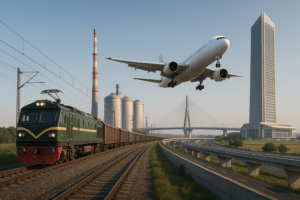Pakistan is on the verge of a massive transformation with several ambitious mega projects set to redefine the nation’s economic and infrastructural landscape. These projects aim to uplift the country to the levels of developed nations like China and Singapore. With these developments, Pakistan is expected to boost its economy, pay off debts, improve infrastructure, and create numerous job opportunities for its citizens. Here are the top five mega projects that will change Pakistan’s future in 2025.

1. Special Economic Zones (SEZs)
One of the most significant initiatives under the China-Pakistan Economic Corridor (CPEC) is the development of Special Economic Zones (SEZs). These zones are designated areas where businesses and investors enjoy tax exemptions, duty-free imports, and other incentives. The purpose of these SEZs is to attract foreign investments, promote industrialization, and increase exports.
Pakistan has planned to establish around 12 SEZs, including:
- Allama Iqbal Industrial City
- Bostan Industrial Zone
- Dhabeji Economic Zone
- Rashakai Economic Zone
- Gwadar Free Zone
The Gwadar Free Zone will be Pakistan’s first duty-free city, allowing investors to operate without customs duties or taxation. If successful, these SEZs could replicate the economic success seen in countries like China, Thailand, and Singapore, leading to industrial growth and economic prosperity.
2. ML-1 Railway Project
Railway infrastructure is crucial for industrial progress, and Pakistan’s Main Line-1 (ML-1) railway project is set to revolutionize the country’s transport system. ML-1, a flagship project of CPEC, will upgrade the existing railway network from Karachi to Peshawar, significantly reducing travel time and boosting cargo transport capacity.
Once completed:
- Travel time from Karachi to Lahore will be reduced to just 10 hours.
- Lahore to Islamabad will take only 2.5 hours.
- Freight capacity will increase from 4% to 20%.
- Train speeds will increase up to 140 km/h.
This project will modernize Pakistan’s outdated railway system, making it more efficient and competitive in the region. The estimated cost of the ML-1 project is around $6.8 billion, with China financing a major portion of it. The project is expected to be completed in multiple phases, with the first phase beginning in 2025.
3. Rawalpindi-Murree Glass Train
Pakistan’s tourism industry is set to receive a major boost with the introduction of the country’s first-ever glass train. This train will run from Rawalpindi to Murree and extend to Muzaffarabad, offering breathtaking views of the scenic mountains through glass windows.
Key highlights of the project:
- A 65 km-long train route starting from Saddar, Rawalpindi.
- The train will pass through beautiful locations like Margalla Hills and Bhurban.
- More than 50 bridges will be constructed for the railway line.
- Expected to cater to over 5 million tourists annually.
The primary aim of this project is to promote tourism in Pakistan and provide a luxurious and comfortable travel experience to visitors. The project is currently in the planning phase and is expected to be completed in the next two years.
4. Gwadar International Airport
Gwadar International Airport, the largest airport in Pakistan, has been completed and is set to be operational in early 2025. Funded primarily by China and Oman, this airport is built to facilitate the growing number of Chinese investors and businesspersons operating in Gwadar.
Project details:
- Spread over 4,300 acres of land.
- Capacity to handle over 400,000 passengers annually.
- Built to support Gwadar’s rapid economic expansion under CPEC.
Despite its strategic importance, the airport has faced criticism from locals who argue that it does not provide significant benefits to the local population. Nonetheless, the airport is expected to play a crucial role in international trade and connectivity, strengthening Pakistan’s position as a key player in global logistics.
5. Lahore-Sahiwal-Bahawalnagar Motorway
Another crucial infrastructural project is the Lahore-Sahiwal-Bahawalnagar Motorway, which has recently been approved. This project is designed to enhance connectivity in Punjab, facilitating trade and transportation across the province.
Project specifications:
- Estimated cost: PKR 463 billion.
- 90% of land acquisition has been completed.
- Expected to significantly boost economic activity in southern Punjab.
The motorway project has sparked controversy over funding distribution, as federal resources are being used for a provincial project. Despite this, the project is expected to bring immense benefits to the region, making transportation faster and more efficient.
Conclusion
Pakistan is at a turning point in its economic development. These five mega projects have the potential to significantly transform the country, providing jobs, boosting industrialization, and improving infrastructure. If executed properly, they can lead Pakistan towards a more prosperous and developed future, making it a key economic hub in the region.
As we move towards 2025, these projects offer a glimpse of the brighter future that awaits Pakistan. With proper planning and execution, these initiatives will pave the way for long-term economic stability and growth.
